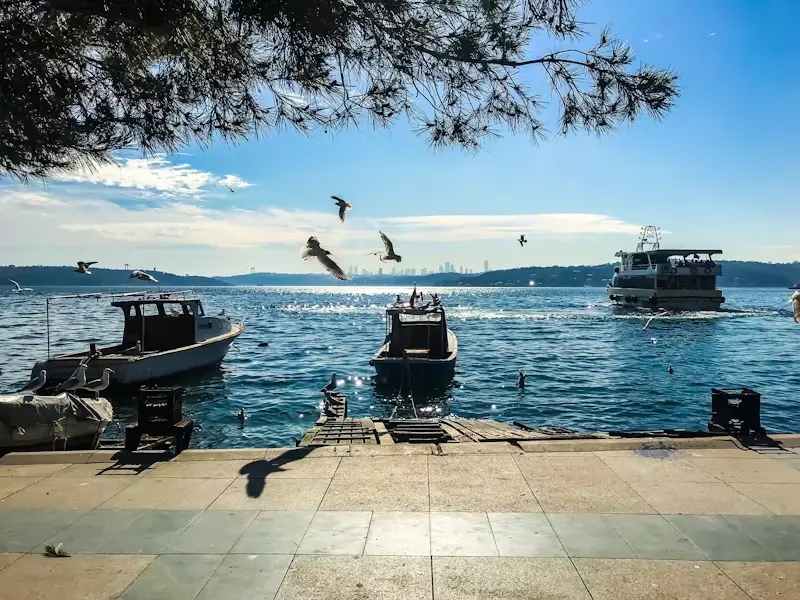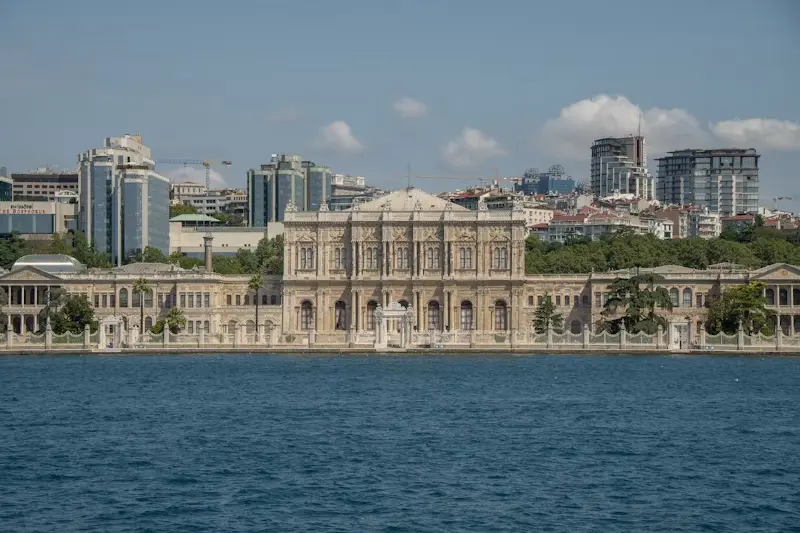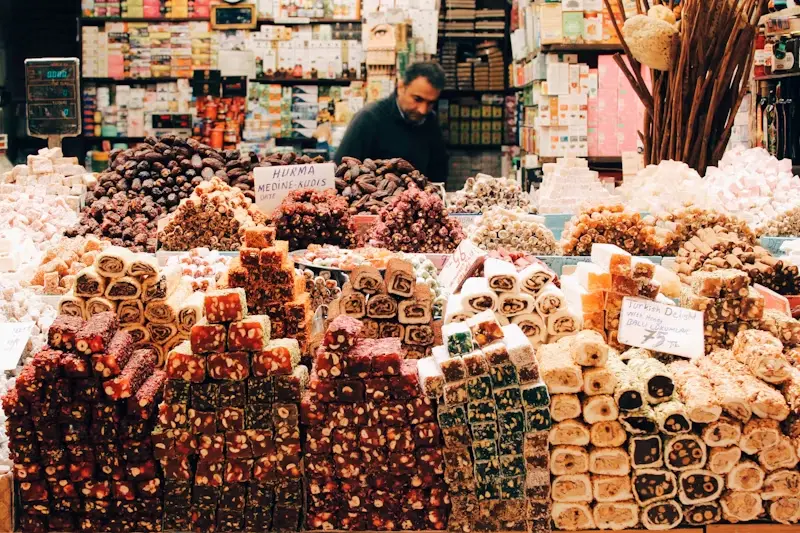Istanbul Guide: The Ideal Itinerary for 3 Days to a Week

Whether you're plotting a 3-day Istanbul itinerary or planning to immerse yourself fully with one week in Istanbul, this guide promises to unveil the secrets of navigating the city with the zest and zeal of a seasoned explorer. From the remnants of the Ottoman Empire to the bustling Taksim Square, every corner of Istanbul is steeped in stories waiting to be discovered.
Before we embark on this exhilarating journey through Istanbul, let's address a crucial aspect of travel - managing your luggage efficiently. Roaming this expansive city is most enjoyable when your bags do not weigh you down. Thankfully, Nannybag's Istanbul luggage storage facilities offer a convenient solution. Securely store your luggage as you traverse the Bosphorus Strait or indulge in Turkish delight; Nannybag ensures your exploration is as carefree as the city's vibrant spirit. With easy online booking, 24/7 availability, and numerous locations across the city, you're all set for an unburdened adventure.
How to Make the Best Out of Istanbul in One Week?
Embarking on a one-week journey in Istanbul allows you to deeply explore the rich tapestry of this city's past and present. Here's a breakdown of how to fill your days with wonder and discovery.
Days 1-3: The Heart of Istanbul
Embarking on a journey through Istanbul, the beating heart of history, culture, and architectural grandeur, your adventure unfurls in Sultanahmet Square. This historic locale isn't just a square; it's a canvas that paints centuries of history through its awe-inspiring landmarks. Here's how to immerse yourself in the essence of Istanbul right from the start:
Sultanahmet Square: A Historical Overview
Sultanahmet Square serves as the cornerstone of your exploration. This area, pulsating with the echoes of the past, is home to some of Istanbul's most iconic sights:
- Hagia Sophia: Once a cathedral, then a mosque, and now a museum, the Hagia Sophia stands as a monument to the Byzantine and Ottoman empires. Its majestic dome has stood the test of time, offering visitors a glimpse into architectural innovation and religious significance across centuries.
- Blue Mosque: Officially named Sultan Ahmed Mosque, this site is known as the Blue Mosque for the blue tiles adorning its interior. It remains a functional mosque, blending daily worship with tourist admiration. Its six minarets and grandiose size capture the essence of Ottoman architecture and spiritual devotion.
- Basilica Cistern: A marvel of engineering, the Basilica Cistern is a vast underground water reservoir built in the 6th century. Its dimly lit, serene atmosphere and the sound of dripping water create a mystical experience, with the Medusa head pillars adding a touch of ancient mythology.
Recommended Activities:
- Guided Tours: Guided tours are invaluable for truly appreciating these landmarks' historical depth and architectural brilliance. Experienced guides provide fascinating backstories and lesser-known facts that enrich your understanding. For first-time visitors, this is a way to navigate the rich history efficiently, ensuring you don't miss out on the intricate details that bring these monuments to life.
- Mind the Prayer Times: If you plan to visit the Blue Mosque, you must know the Islamic prayer times. These times may affect visitation hours, as the mosque is closed to tourists during prayers. Respecting these religious practices adds to the cultural immersion of your journey.
The Spice Bazaar and Grand Bazaar: A Sensory Exploration
After soaking in the historical magnificence, let your senses lead you to the Spice Bazaar and Grand Bazaar. These markets are not just shopping destinations; they are cultural experiences:
- Spice Bazaar: Known for its aromatic ambiance, the Spice Bazaar is a colorful maze of spice, herb, and fruit stalls. Each spice tells a story, from the Silk Road's ancient trade routes to modern-day culinary practices. It's a place to taste, smell, and explore the flavors that define Turkish cuisine.
- Grand Bazaar: One of the largest and oldest covered markets in the world, the Grand Bazaar encapsulates the essence of Istanbul's trading history. With over 4,000 shops, it offers a bewildering array of goods, from handcrafted jewelry and ceramics to textiles and antiques. The alleys buzz with the energy of commerce, haggling, and the melding of cultures.
Tips for Visitors:
- Haggle with Respect: Bargaining is part of the experience in these bazaars. Approach it with a friendly attitude and respect for the vendors. It's a way to engage with the local culture and possibly secure a better deal.
- Culinary Delights: Don't miss the chance to try Turkish delights, baklava, and traditional Turkish tea or coffee from the local stalls. These flavors are integral to the Turkish experience.
Storing Your Finds:
After a day of exploration and shopping, you might want to offload your treasures before continuing your adventure. This is where Nannybag's Istanbul luggage storage facilities come into play, offering a secure spot to store your shopping haul as you continue to explore.
Days 4-5: The Cultural Tapestry
As your journey through Istanbul continues, the narrative weaves through the contrasting yet complementary tales of imperial grandeur and modern-day buzz. Venturing beyond the ancient relics of Sultanahmet Square, you'll find yourself at the threshold of the city's more recent yet equally fascinating history, highlighted by Dolmabahçe Palace and Chora Church. Meanwhile, the vibrant streets of Istiklal and Taksim Square offer a lively glimpse into the city's contemporary heart.

Dolmabahçe Palace: The Last Breath of Empire
Dolmabahçe Palace is a testament to the opulence and splendor of the late Ottoman Empire. Erected along the picturesque Bosphorus shores, this palace merges traditional Ottoman architecture with European influences, reflecting the empire's position at the crossroads of continents.
- Architectural Marvel: With its elaborately decorated interior, the palace showcases an impressive collection of Bohemian crystal chandeliers, notably the world's largest crystal chandelier, gifted by Queen Victoria. The blend of Baroque, Rococo, and Neoclassical styles, alongside traditional Ottoman elements, illustrates the cultural and artistic exchange of the era.
- Historical Significance: Dolmabahçe is not just an architectural gem; it's a historical pivot. Serving as the administrative center and residence of the last Ottoman sultans, it witnessed the empire's final days and the early years of the Turkish Republic. Atatürk, the founder of modern Turkey, spent his last days in this palace, adding a solemn layer to its historical narrative.
Chora Church: A Byzantine Masterpiece
A short journey from the imperial Ottoman landmarks leads to Chora Church, a sanctuary of Byzantine art. This church, lesser known than Hagia Sophia but equally captivating, is adorned with some of the most exquisite mosaics and frescoes depicting scenes from the Christian tradition.
- Artistic Heritage: The meticulously restored mosaics and frescoes offer a vivid window into Byzantine artistic achievement. The portrayal of biblical stories through art, especially in the church's Naos, Narthex, and Parecclesion, provides an immersive spiritual and aesthetic experience.
- Evolution Over Centuries: Chora's history mirrors the city's religious and cultural transformations, having served as a church, mosque, and now a museum. This evolution speaks to the layers of Istanbul's identity, shaped by its Byzantine and Ottoman past.
Navigating Istanbul: The Pulse of Modernity
Istiklal Street and Taksim Square offer a lively contrast when transitioning from the historical depths to the heartbeat of modern Istanbul. This area is the epicenter of contemporary Istanbul life, buzzing with energy, creativity, and the spirit of youth.
- Istiklal Street: Stretching from Taksim Square to Galata, this pedestrian thoroughfare is lined with shops, cafes, and cultural venues. Whether you're in the mood for street food, interested in browsing local boutiques, or looking to experience Istanbul's dynamic nightlife, Istiklal Street is the place to be.
- Taksim Square: As a major public space, Taksim Square is a gathering place for celebrations, demonstrations, and social life. Surrounded by hotels, cultural centers, and the iconic Republic Monument, it symbolizes modern Turkey's identity.
Efficient Travel Tips:
- Public Transportation: Istanbul's extensive public transportation network, including metro, tram, and ferries, is your best ally in exploring these diverse facets of the city. It offers an efficient, affordable way to navigate historical depth and modern vibrancy, providing a cohesive experience of Istanbul's multifaceted character.
Days 6-7: The Bosphorus and Beyond
As your exploration of Istanbul unfolds, the journey takes a captivating turn toward the waters that define the city's unique geography and cultural fusion. The Bosphorus Strait, a natural strait that not only separates Europe and Asia but also unites cultures, traditions, and histories, offers an experience that transcends mere sightseeing. The city's culinary landscape also promises an adventure for the palate, blending flavors that tell tales of empires, trade routes, and a melting pot of civilizations.
The Bosphorus Experience: A Journey Between Continents
A cruise on the Bosphorus Strait is more than a passage through water; it's a voyage across time and cultures. These cruises provide a vantage point unlike any other, presenting Istanbul's skyline in a panoramic embrace.
- Scenic Views: From the serene waters, witness the juxtaposition of Istanbul's historic mosques and palaces against the backdrop of its modern skyscrapers and residences. The sight of fishermen lining the bridges, ferries darting across the strait, and seagulls soaring above adds life to the picturesque scenes.
- Architectural Marvels: The cruise highlights architectural wonders that dot the Bosphorus shores, including the Dolmabahçe Palace, Rumeli Fortress, and the Beylerbeyi Palace, each with a story of glory and intrigue.
- Cultural Immersion: Opt for a cruise that includes stops at quaint villages and neighborhoods along the strait. These stops offer a glimpse into the daily lives of locals and the rich cultural tapestry that makes up the city.
Travel Tips:
- Sunset Cruises: For a truly magical experience, consider a sunset cruise. Watching the sun dip below the horizon, casting golden hues over the city and the waters, is a moment of unparalleled beauty.
- Cultural Events: Some cruises feature live performances of traditional Turkish music and dance, providing a cultural feast as you sail between continents.
Culinary Delights: An Epicurean Journey
Istanbul's culinary scene is as diverse as its heritage, offering many flavors that cater to every taste and preference. The city's position as a cultural crossroads is reflected in its food, combining elements from Middle Eastern, Mediterranean, and Central Asian cuisines.
- Rooftop Dining: Many restaurants in Istanbul take advantage of the city's stunning vistas by offering rooftop dining experiences. Enjoying a meal with views of the Bosphorus, the Galata Tower, or the Hagia Sophia transforms dining into an event, combining gastronomy with breathtaking scenery.
- Local Cafes and Eateries: Venture into the side streets and alleyways to discover cozy cafes and eateries that serve authentic Turkish dishes. From simit (Turkish bagel) vendors to local kebab houses, these spots offer a taste of daily life in Istanbul.
- Must-Try Dishes: Your culinary exploration wouldn't be complete without tasting traditional Turkish delights, the succulent varieties of kebabs, meze (a selection of small dishes served as appetizers), and the famed Turkish tea and coffee. Sampling raki, the anise-flavored national drink, is a cultural experience for the adventurous.
Enhancing Your Culinary Adventure:
- Cooking Classes: For those interested in taking a piece of Istanbul home, participating in a cooking class is a rewarding experience. Learn how to prepare traditional Turkish dishes under the guidance of local chefs.
- Food Tours: Joining a food tour can provide an insider's look into Istanbul's culinary scene, from bustling markets to hidden dining gems.

TLDR: 3 Days in Istanbul: A Condensed Itinerary
Short on time? In just three days, you can still immerse yourself in Istanbul's cultural, historical, and culinary highlights. Here’s a focused itinerary that covers highly recommended sites and experiences:
Day 1: Exploring Sultanahmet - The Historical Heart of Istanbul
Morning:
- Hagia Sophia: Start your day at one of Istanbul’s most iconic landmarks. This architectural marvel is a testament to the city's complex religious history. Spend the morning exploring its stunning interior and impressive dome structure, which has stood since 537 AD.
- Blue Mosque: Just a short walk from Hagia Sophia, the Blue Mosque, famed for its striking blue tiles and unique six minarets, awaits. Remember to check the prayer times, as the mosque is closed to tourists during these times.
Afternoon:
- Basilica Cistern: A few steps away, descend into the mesmerizing Basilica Cistern. This ancient cistern, built in the 6th century, offers a glimpse into the ingenious urban planning of Byzantine Constantinople.
- Lunch: Enjoy a traditional Turkish lunch at a nearby restaurant. Sample classics like kebap, mezze platters, and the renowned Turkish delight.
Late Afternoon:
- Topkapi Palace: Conclude your day with a visit to Topkapi Palace, a large museum once the Ottoman sultans' residence. The palace exhibits many sacred Islamic relics, including Muhammad’s cloak and sword.
Day 2: From the Bazaars to the Galata Tower
Morning:
- Spice Bazaar: Begin your day at the Spice Bazaar, one of Istanbul’s oldest markets, known for its abundance of fragrant spices, herbs, and delightful Turkish delights.
- Grand Bazaar: Continue to the Grand Bazaar for a more extensive shopping experience. One of the world's largest and oldest covered markets, it houses over 4,000 shops selling everything from jewelry to handmade carpets.
Afternoon:
- Lunch: Grab a quick bite at one of the local eateries within the bazaar, trying out kofte (Turkish meatballs) or pide (Turkish pizza).
- Süleymaniye Mosque: Post lunch, visit the magnificent Süleymaniye Mosque, an impressive work of Ottoman architecture commissioned by Suleiman the Magnificent.
Evening:
- Galata Tower: In the evening, head towards the Galata Tower and ascend to its upper balcony for panoramic views of Istanbul. This medieval stone tower, built in 1348, offers a 360-degree view of the old city.
Day 3: Bosphorus Strait and Modern Istanbul
Morning:
- Bosphorus Cruise: Start your day with a relaxing cruise on the Bosphorus Strait. This scenic cruise offers views of opulent palaces, ancient castles, and other significant landmarks lining the shores of Asia and Europe.
- Breakfast on the Boat: Enjoy a traditional Turkish breakfast onboard featuring cheeses, olives, honey, and clotted cream (kaymak).
Afternoon:
- Dolmabahçe Palace: Once ashore, visit the Dolmabahçe Palace, which highlights the luxurious lifestyle of the late Ottoman sultans. The palace’s crystal staircase and ceremonial hall are exceptionally breathtaking.
- Lunch: Sample some seafood at a café near the palace, overlooking the Bosphorus.
Evening:
- Taksim Square: Conclude your trip with a visit to Taksim Square, a major shopping, tourist and leisure district famed for its restaurants, shops, and hotels.
- Istiklal Street: Walk along Istiklal Street, a vibrant street with boutiques, cafes, and historic patisseries. Don’t miss trying some baklava at one of the classic bakeries.
Tips for a Seamless Istanbul Experience
Navigating a new city, especially one as historically and culturally dense as Istanbul, can be daunting. Here are some detailed tips to help you manage your time efficiently and enhance your visit:
Public Transportation: Mastering the Network
Istanbul boasts a comprehensive public transportation system that includes trams, buses, ferries, and the metro. Using these can significantly reduce your travel costs and avoid traffic jams:
- Istanbulkart: Purchase an Istanbulkart, available at kiosks and vending machines at major transit stops. This rechargeable card can be used on all public transport and offers discounted fares compared to single tickets.
- Tram and Metro: The tram and metro are the most convenient options for most tourist destinations. The T1 tram line connects significant sites in Sultanahmet to more modern parts of Istanbul.
- Ferries: Don’t miss using the ferries to cross the Bosphorus or to visit the Princes' Islands. Ferries provide a scenic and economical route across the city.
- Apps to Use: Consider using apps like 'Istanbul Metro Map' and 'Trafi', which provide real-time transit directions and line schedules.
Opening Hours and Prayer Times
When planning your visit, particularly to religious and culturally significant sites, timing is essential:
- Regular Hours: Most tourist attractions operate between 9:00 AM and 7:00 PM, but times can vary by season. Many museums are closed on Mondays.
- Religious Sites: Mosques such as Hagia Sophia and the Blue Mosque are active religious sites that close five times daily for prayer for half an hour each time. They are usually open to tourists from 8:30 AM to one hour before dusk, except during prayer times.
- Respectful Visits: Be mindful of Islamic prayer times, especially on Fridays, and dress modestly when visiting mosques (covering shoulders and knees, and women should carry a scarf to cover their heads).
Guided Tours: Enhancing Your Understanding
Guided tours can provide deeper insight into Istanbul’s rich tapestry of history and culture:
- Professional Guides: Opt for licensed professional guides who can offer comprehensive historical context and hidden anecdotes that enrich your experience.
- Private Tours: Consider booking private tours for a more personalized experience, especially at sprawling sites like Topkapi Palace and the Grand Bazaar.
- Walking Tours: Join thematic walking tours that focus on specific aspects, such as Ottoman history, Byzantine Istanbul, culinary trails, or art and architecture.
- Language-Specific Tours: Many tour operators offer services in multiple languages. To fully appreciate the narratives, ensure you book tours in a language you’re comfortable with.
Additional Tips:
- Stay Connected: Buy a local SIM card or rent a pocket WiFi to stay connected and navigate the city easily via Google Maps or similar apps.
- Cultural Etiquette: Turkish culture values courtesy and respect. Greet with a smile and say "Merhaba" (Hello) or "Teşekkür ederim" (Thank you). It goes a long way in making friendly local connections.
- Cash and Currency: While many places accept credit cards, having some cash (Turkish Lira) is crucial for smaller shops and public transportation. Currency exchange offices in Sultanahmet or Taksim offer better rates than at the airport.

Say hello to exploring and goodbye to heavy bags!
What if you could enjoy every minute in the city without the burden of your bags?
- Safe luggage storage for a flat daily price of ₺150,00/luggage item
- Included luggage protection of up to €10000 in case of breakage, loss or theft
